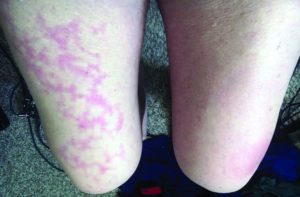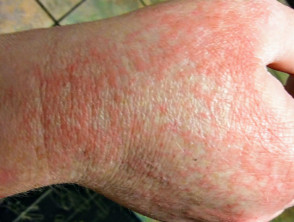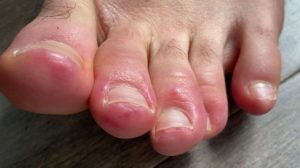
The most common initial symptoms of COVID-19, according to the Centers for Disease Control and Prevention (CDC), are fever, dry cough and shortness of breath. However, skin rashes and other mild skin changes also appear to be among coronavirus symptoms in some patients.
One of the most troubling aspects of the pandemic is the wide range of symptoms that are noticed when screening patients, making it easy to misdiagnose. Because skin rash/skin changes are among these signs, it’s worth knowing what to look for.
New research suggests a link
In a limited study of 88 coronavirus patients in Italy, one of the regions hardest stricken by the virus, about one in five (20%) of patients who ultimately tested positive for COVID-19 also had skin-related symptoms before, during or after diagnosis. Similar findings have been reported by physicians and dermatologists in the United States, and the French National Union of Dermatologists-Venereologists (SNDV) shared their observations amongst 400 members using an organized discussion on WhatsApp.
Skin symptoms linked to COVID-19
 Redness, blotchiness or tiny bumps on the skin (morbilliform)
Redness, blotchiness or tiny bumps on the skin (morbilliform)- frostbite-like changes (acral ischemia)
- persistent redness that can be painful
- Mottled or lace-like discoloration of the skin (livedoid vascular eruption)
- Striations which may appear to be ruptured blood-vessels or capillaries (petechiae)
- Hives or welts (urticaria)
- Bumps or vesicles which may resemble chicken-pox blisters
Reports by clinicians treating COVID-19 patients who also showed dermatologic symptoms have noted that skin rash or skin changes do not appear to be related to the severity of other symptoms or disease progression. In some cases, there were few or no other coronavirus symptoms at first. In others, the rash subsided but other symptoms later emerged or worsened resulting in hospitalization.
Skin changes can be related to many things
 More research is needed to better understand why some COVID-19 patients also present with dermatologic symptoms and others do not, but it is worth noting these types of skin rashes often occur with other viruses as well. In addition, a skin rash may be tied to new medications, changes in diet or environmental factors.
More research is needed to better understand why some COVID-19 patients also present with dermatologic symptoms and others do not, but it is worth noting these types of skin rashes often occur with other viruses as well. In addition, a skin rash may be tied to new medications, changes in diet or environmental factors.
Check it out
Changes in your skin such as those listed may warrant a closer look, especially if noticed along with any of COVID-19’s other symptoms or if you may have been exposed to coronavirus.
If you have recently noticed a rash or other change in your skin, consult with your dermatologist or contact me for an appointment today.
Previous Post Next Post